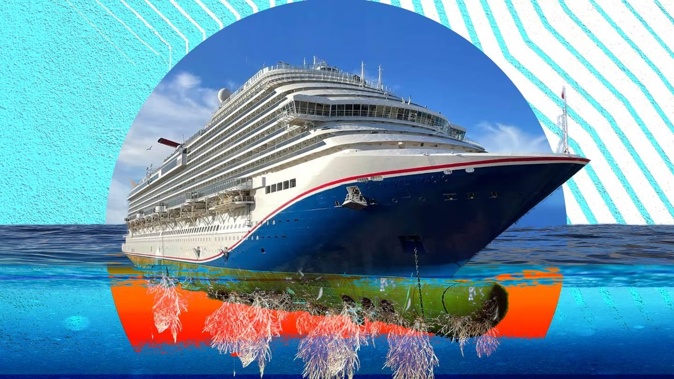
Shining white above the surface, pleasure cruisers have a grubbier side that represents a risk to New Zealand’s marine ecosystem.
This summer, alien invaders and non native species have been found stuck to the underside of ships with an alarming rate this summer. Otherwise known as “biofoul” - the term for crustaceans, barnacles and algae found hitchhiking on ships - it has become a hot topic for cruise lines in Australia and New Zealand.
Since the return of cruise ships to New Zealand’s waters in August, five ships have been stopped for marine biofoul notices. Some for multiple offences.
This weekend both the Queen Elizabeth and the Oceania Regatta were pulled up by the Ministry of Primary Industries for their dirty bottoms. Regent Seven Seas Explorer and the Coral Princess, which was infested by sea snails, were also given warnings over dirty hulls. The knock on effect for passengers can mean delays, change in itineraries and - in some cases - can see ships being barred from sensitive areas such as Milford Sound of the Bay of Islands. Each time ships must be cleaned and inspected in designated ports or areas or leave for international waters.
This Summer the Viking Orion was issued two separate NODs from Biosecurity NZ regarding biofoul. The ship was first informed of foreign matter found on its hull on 15 December, and again for a separate biofoul find on 20 December.
The ship was again held at the Australian border on 28 December after “small amounts of biofoul” were found by the Australian agricultural department.
Operators of the Orion say it has since “been cleared by New Zealand authorities to enter New Zealand waters, following additional exterior cleaning” was working to compensate passengers for the disruption and missed ports.
So, what is behind this subsea alien invasion? And has anything changed to make biofouling more prolific?
/cloudfront-ap-southeast-2.images.arcpublishing.com/nzme/76RCIV2PGAJO7YLMROU5GZXYZA.jpg)
Alien invasion: Biofouling refers to non-native marine species like barnacles, transported on a ship's hull. Photo / Wikimedia Commons
On Monday the New Zealand Cruise Association and MPI met to discuss the issue.
Chief executive of NZCA Kevin O’Sullivan said that nothing had changed in terms of regulation. The current biofouling rules have been in place since 2018.
“Protecting New Zealand’s unique marine environment is very important for cruise lines, especially in our most sensitive areas,” he said.
Of course not only cruise ships are capable of carrying biofoul into New Zealand’s waters, however they come under much stricter scrutiny.
“The standards that apply to cruise ships are at a higher level because visiting sensitive areas outside of commercial ports is often part of their itinerary,” said O’Sullivan.
It is the appeal of sailing around New Zealand’s natural treasures such as Fiordland that make the issue of biofoul so important.
Paul Hallett, manager environmental health for Biosecurity NZ, said that the majority of cruise ships visit New Zealand with no issue.
“In the past few weeks, we gave directions to three cruise ships [visiting] New Zealand,” he said.
“Ships have just started operating again post-pandemic and it would be too early to say whether there is an increase or a decrease.”
Out of 6121 international arrivals to New Zealand from 1 January 2020 to September 2022 around 6 per cent were cautioned for bio-fouling issues.
Although there has been a spike biofoul found on recent arrivals, Hallet said it was worth noting that there had been occasional notices given to cruise ships prior to the pandemic.
With the post-Covid maritime border only recently allowing cruise ships back into the country, he hopes analysis at the end of the season will give a clearer picture.
/cloudfront-ap-southeast-2.images.arcpublishing.com/nzme/KXIO3SV6ZYL3ETAQCGOCJPTHWA.jpg)
Viking Orion was issued two biofouling warnings from Biosecurity NZ this season. Photo / Supplied
Could warming oceans bring more biofoul?
Since 2014 MPI and Biosecurity NZ have been scouring the underside of ships for invasive marine species.
However, biofoul is not a problem exclusive to New Zealand.
Last year a study by Cambridge University researchers showed that Antarctica was seeing an increase in alien maritime organisms, driven by a boom in Antarctic cruise shipping.
The increase of tourism vessels were seen as a high risk factor for transporting alien species to the Antarctic, due to their more frequent and shorter itineraries which tended to be during warmer seasons.
Moreover with Antarctica having no native marine bioscreening and more shipping not arriving via the traditional gateway ports - such as Lyttelton and Christchurch - the potential for biofouling to arrive unchecked was growing.
“Antarctica is globally connected,” researcher Arlie McCarthy told the Herald.
Separately, studies into warming ocean temperatures suggest that changing marine climate may lead to more prolific algae and biofoul growths on shipping.
In 2019 Sergey Dobretsov published a warning that “oceans are changing” to lead to more resilient growths on shipping, and invasive species travelling further to more remote locations.
“Undoubtedly, with Climate Change fouling management will become an even greater challenge,” he said.
Take your Radio, Podcasts and Music with you









